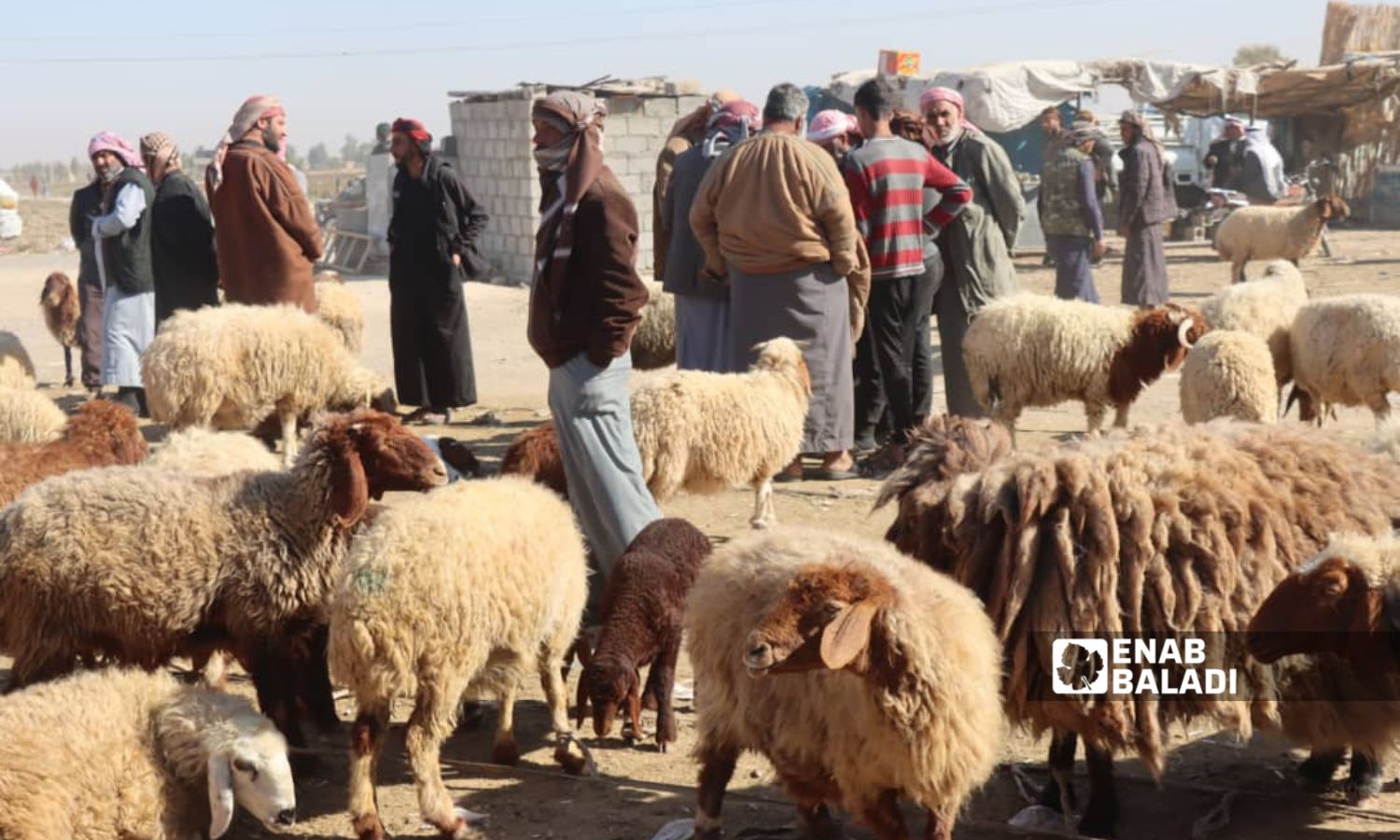



Deir Ezzor – Obadah al-Sheikh
Livestock prices in the countryside of Deir Ezzor in eastern Syria have dropped by more than 60% due to a lack of pastures resulting from a drought affecting the region, in addition to rising prices of ready-made fodder.
According to Enab Baladi’s correspondent in Deir Ezzor, the falling prices have raised concerns among livestock breeders and traders about a further decline, potentially leading to significant financial losses.
Breeders are resorting to buying fodder at high prices, with the cost of a ton of bran and barley reaching $350, while dry bread costs $275, alfalfa is $300, and wheat straw is $130 (1.3 million Syrian pounds, considering that one dollar equals 10,000 pounds).
The 60% drop in prices has exposed many livestock breeders and traders to financial losses, including Abdul Rahman al-Faqr from the town of Shaqra in western Deir Ezzor, who is a breeder and trader in the sheep market.
Al-Faqr told Enab Baladi that sales have decreased “significantly” due to the price drop, resulting in a loss of more than 20 million Syrian pounds in the first week of February.
He mentioned that the price of a female sheep has become 600,000 Syrian pounds, and the price of a large ram has not exceeded one million pounds today, a drop of more than half of the price from a month ago.
On his part, Salem al-Jassim, a broker in the sheep market, stated that demand has decreased and now only comes from meat shop owners.
He mentioned to Enab Baladi that most sheep breeders bring their livestock to sell in the morning, but they return with the same animals when the market closes, a recurring situation over the past few days.
Latouf al-Hassan, a sheep and cow breeder in the town of al-Tayana in eastern Deir Ezzor, attributed the drop in livestock prices to a reduction in rainfall and the unavailability of natural pastures.
He told Enab Baladi that this situation is similar to what happened in 2021 when the region experienced drought and low rainfall.
Additionally, livestock breeders have called for the Autonomous Administration of North and East Syria (AANES) to intervene and support the sector, open the borders with Iraq for livestock export, and revive activity among livestock breeders, awaiting a response.
With the fall of the previous Syrian regime, the Iraqi authorities announced the complete closure of the al-Qaim border crossing with Syria, stating that the Iraqi borders are secured, and crossing in and out through this crossing is not permitted, alongside the complete closure of crossings with Syria, which will only be opened under certain conditions.
On January 8, the Iraqi government announced the completion of the construction of a 400-kilometer concrete wall between the Iraqi and Syrian borders, and on February 6, the Iraqi Ministry of Defense reported that smuggling across the Iraqi-Syrian border had dropped to zero for the first time since 2003.
A source from the Farmers’ and Animal Wealth Union in eastern Deir Ezzor (who preferred to remain anonymous as they are not authorized to speak to the media) stated that the livestock sector is facing several challenges, primarily the decreasing number of livestock.
The source added to Enab Baladi that most breeders have been forced to sell their herds in recent years, fearing their death and their inability to meet their needs, alongside rising costs of care.
He emphasized the urgent need to activate veterinary centers and provide fodder, in addition to ongoing support to revitalize the livestock sector, noting that the region relies primarily on livestock farming.
According to the latest statistics from the Farmers’ and Animal Wealth Union in Deir Ezzor, the number of livestock has reached 950,000 heads of sheep, 45,000 heads of cattle, and approximately 7,500 camels and horses.
The decline in livestock prices has reflected on meat prices in local markets in the countryside of Deir Ezzor.
Ayman al-Saloum, a butcher in the countryside of Deir Ezzor, stated that sheep meat prices have dropped from 160,000 Syrian pounds per kilogram to 75,000 pounds, while beef prices have decreased from 140,000 pounds to 80,000 pounds per kilo, adding that purchasing activity for the meat has increased.
Livestock breeders in Syria are facing multiple difficult circumstances, leading many to consider leaving the profession, whether or not alternatives exist; they are now forced to sell their livestock if there are buyers, or slaughter them to relieve the burden of their costs.
Before 2011, livestock farming in Syria accounted for approximately 40% of the total agricultural production and provided job opportunities for about 20% of the workforce in rural areas, according to a study by the international organization “IMMAP,” published in May 2021.
The average rate of rural households in Syria for whom livestock farming is the main source of food and income is around 35%.
if you think the article contain wrong information or you have additional details Send Correction